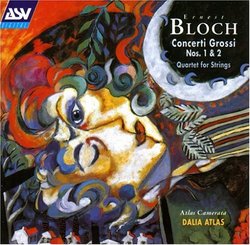| All Artists: Ernest Bloch, Dalia Atlas Title: Bloch: Concerti Grossi Nos. 1 and 2 / String Quartet Members Wishing: 0 Total Copies: 0 Label: Asv Living Era Release Date: 4/24/2001 Genre: Classical Styles: Chamber Music, Forms & Genres, Concertos, Historical Periods, Classical (c.1770-1830), Instruments, Keyboard Number of Discs: 1 SwapaCD Credits: 1 UPC: 743625105520 |
Search - Ernest Bloch, Dalia Atlas :: Bloch: Concerti Grossi Nos. 1 and 2 / String Quartet
 | Ernest Bloch, Dalia Atlas Bloch: Concerti Grossi Nos. 1 and 2 / String Quartet Genre: Classical
|
Larger Image |
CD Details |
CD ReviewsBloch in Neo-Baroque Mode Thomas F. Bertonneau | Oswego, NY United States | 04/30/2001 (4 out of 5 stars) "Howard Hanson and the Eastman Rochester Orchestra established the benchmark for performances of Ernest Bloch's (1880-1959) two CONCERTI GROSSI (1925 and 1952) with their recording on Mercury in 1959. Bloch wrote the first CONCERTO GROSSO while on faculty at the Cleveland Institute of Music, one of his stopover assignments on the way to Berkeley, California, and (in retirement) Agate Beach, Oregon. It seemed modern to audiences of the day but is likely to strike contemporary ears as late-Romantic in its vocabulary. Some of the "Jewish" Bloch surfaces here and there in the score - in the opening Prelude and again in the ensuing slow movement ("Lament"). The Third Movement ("Pastorale and Rustic Dances") sounds a bit like the corresponding movement from Magnard's THIRD SYMPHONY. In the Finale, Bloch works up an exciting fugue, bringing back the "Jewish" motif from the Prelude for the stretto. Dalia Atlas delivers a performance less tense, perhaps, than Hanson's, but in bringing out the work's lushness she opens it to another view which we ought to be happy to have. If THE CONCERTO GROSSO NO. 1, despite its name, is not very baroque at all, the CONCERTO GROSSO NO. 2 from more than a quarter of a century later, better lives up to the nomenclature. Where CG No. 1 used strings and piano, CG No. 2 limits the forces to strings, but subdivides the voices to make for a thornier contrapuntal texture - one more in line with what Bloch showed he could do in his first two string quartets. Less immediately accessible than CG No. 1, CONCERTO GROSSO NO. 2 neverthelesss offers more nourishment in the long run. As Colin Wilson noted forty years ago, Bloch's music often has a faintly English quality, and this is apparent in CONCERTO GROSSO NO. 2, some passages of which sound like Elgar or Bliss. Again, Atlas and the "Atlas Camerata" give a muscular performance and do a slightly better job than Hanson's Eastman Rochester players did in bringing out the work's moments of mystical yearning. The CD tracks the four sections of CONCERTO GROSSO NO. 2 separately; Atlas also introduces brief pauses where other performances (e.g. Hanson's) link the movements (four in all) without pause. The separate tracks are an advantage in getting to know the work. The concluding fugue is especially dense and tends to reveal its inner workings only on repeated audition. For good measure, Atlas serves up Bloch's STRING QUARTET NO. 1 (1916), maybe the most audacious and radical score that he wrote. We get two movements, the first and second, arranged for string orchestra. In conception and layout, the QUARTET is so enormous that this music tends to make the two companion-pieces seem a bit trifling; but the CONCERTO GROSSO NO. 2 becomes, in this program, something of a return to a spiky nearly atonal musical language that Bloch ameliorated after his emigration to America. Bloch has enjoyed a revival on CD recently, although many of the issues seem to have dropped from the catalogue. A few years back, Atlas committed to silver disc the hitherto unrecorded SYMPHONY IN E-FLAT (1954) along with two interludes from the opera "MACBETH" (1902) and the "THREE JEWISH POEMS" (1913). In the early 90s, the Laurel label put out a CD of the CONCERTO SYMPHONIQUE FOR PIANO AND ORCHESTRA (1948), coupled with CONCERTO GROSSO NO. 2. Those interested should seek out these discs. They should also snap up the present one. It is a worthy addition to the Bloch discography. [P.S. If Bloch appeals to you, I recommend that you become acquainted with the Swedish composer Gösta Nystroem (1890-1966), who shares many traits with the author of "SCHELOMO." Both Bloch and Nystroem were obsessed by the sea, both employed baroque structures in a modern context with late-Romantic harmonies, and the work of both is animated by a strong mystic impulse in the direction of pantheism. Nystroem's SINFONIA CONCERTANTE FOR CELLO AND ORCHESTRA (1947) is the large-scale rhapsodic counterpart of Bloch's slightly earlier VIOLIN CONCERTO (1938). Nystroem's SINFONIA ESPRESSIVA (1932) bears a strong anticipatory resemblance to Bloch's SINFONIA BREVE and SYMPHONY IN E-FLAT.]" Wonderful Bloch Recordings Thomas F. Bertonneau | 05/13/2004 (5 out of 5 stars) "This compilation of Ernest Bloch's two Concerti Grossi and String Quartets is superb. The true essence of Bloch's intense, vibrant music is brought through quite well, especially in the 1st (Prelude) and 4th (Fugue) movements of Concerto Grosso #1. This CD is an excellent buy for any Neo-Classical or 20th Century music connosouir."
|

 Track Listings (10) - Disc #1
Track Listings (10) - Disc #1